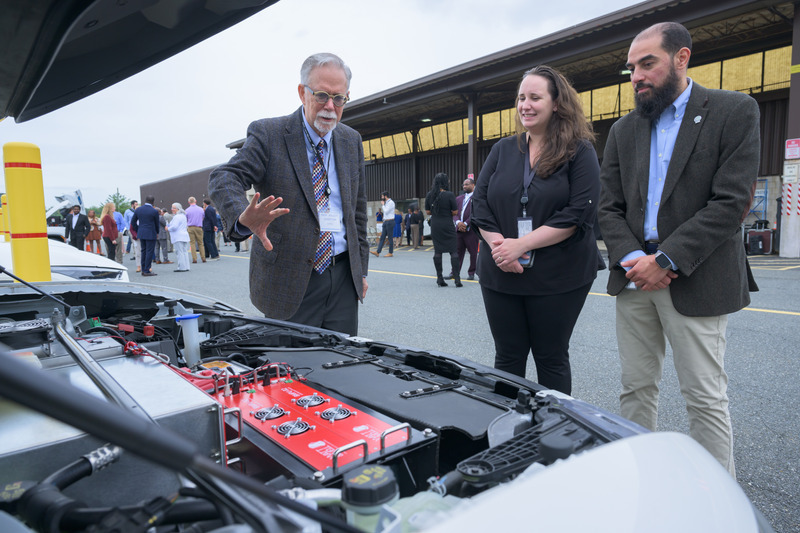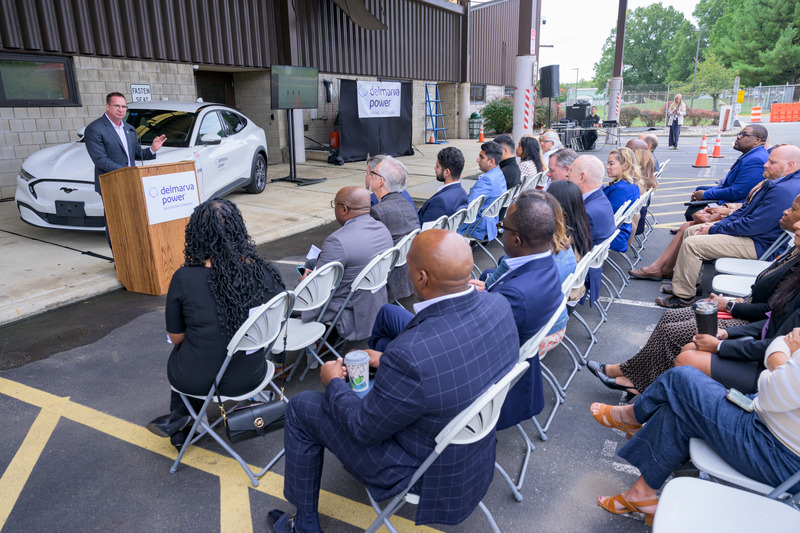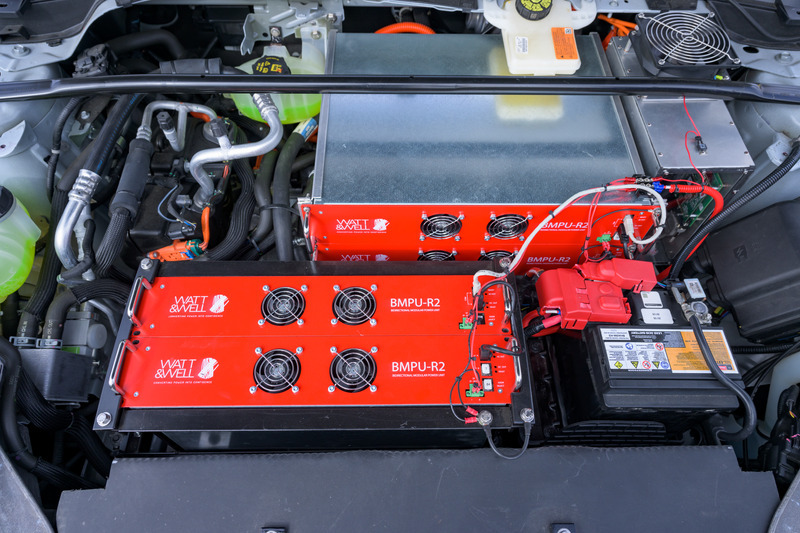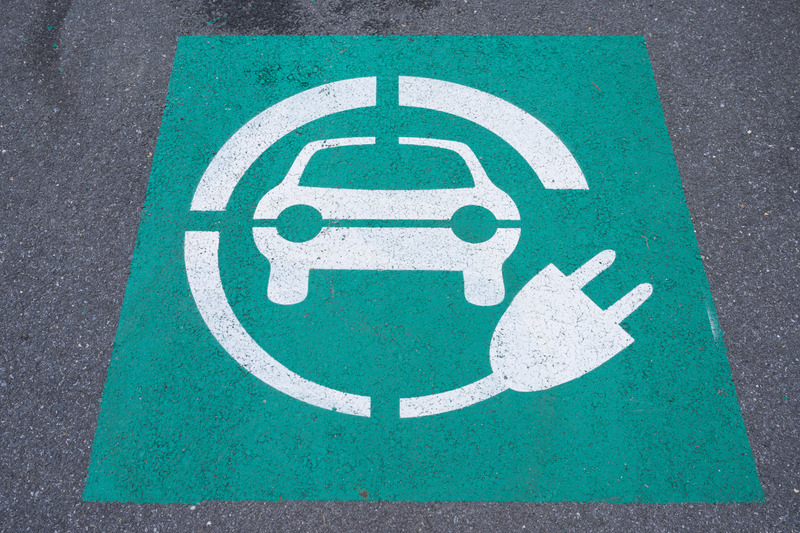

How V2G works featuring Willett Kempton: youtube.com/watch?v=F-hG0ph2_fg
Stabilizing the electric grid
Photos by Evan Krape | Video by Jeffrey C. Chase, Ally Quinn and Sam Kmiec October 04, 2024
V2G is low-cost, scalable demo shows
If there is one reminder from the power outages left in the wake of Hurricane Helene, it’s that our nation’s electric grid has vulnerabilities. Despite the sharp minds and advanced technology designed to keep the power on, sometimes Mother Nature has different ideas.
As the effects of climate change worsen, more challenges may be in store.
On Wednesday, Oct. 2, University of Delaware, Delmarva Power and collaborating industry partners PJM Interconnection and Ford Motor Company showcased how vehicle-to-grid (V2G) power can support the electric grid or provide backup during power failures at a demonstration event in Newark, Delaware.
The pilot project leverages batteries in parked Ford Mach-E electric vehicles (EVs) that are part of Delmarva Power’s transportation fleet to effectively store and contribute energy to the grid in a way that meets all standards and regulations.
Linked together, the Ford Mach-E EV batteries form a virtual power plant, allowing the vehicle batteries to store energy when the grid has too much, such as during off-peak hours, and then return it to help the grid balance demands for electricity when it is needed during peak energy use — all with zero emissions and minimal impact on the planet.
“One distinct advantage of this type of distributed power storage is the ability to provide instant power on a moment’s notice, say, if the larger grid has a failure, for example, or if a generator stops or a large transmission line goes down,” said V2G pioneer Willett Kempton, UD professor of marine science and policy and of electrical and computer engineering.

The event was held during National Drive Electric Week, an annual celebration designed to raise awareness of the benefits of all-electric and plug-in hybrid cars, held this year from September 27 through October 6. In a unique twist, unlike most other Drive Electric Week events, this event focused on the unique value electric vehicles can provide while parked.
The pilot demonstration showcased how the Delmarva Power fleet vehicles could drive for utility operations during their normal work schedule and provide wholesale grid services for PJM Interconnection when parked.
Tyler Anthony, CEO of Pepco Holdings, the holding company for Delmarva Power, pointed to the need for clean energy solutions that will lead the world toward a more resilient future. Scaling up V2G-ready vehicles is one option.
“Think of the benefit of 5,000 EV cars. Think of the benefit of 10,000 parked EV cars, and how we can use that to continue to make energy affordable and have that light switch go on every time, in such a way that allows us to exploit the benefit of all our transition into electric vehicles,” Anthony said.

V2G invented at UD
The V2G technology was invented and developed at UD by Kempton and others in the 1990s through federally funded research. This is the first example of V2G in use where it meets all the standards and regulations for putting power back to the grid in this two-way fashion.
Kempton, who organized the cooperative effort, called the demonstration significant because it shows a cost-effective pathway for standards-based, regulatory-compliant, mass-manufactured V2G.
“This pilot project is the last step to prove everything and to be able to scale V2G to mass production and large scale,” said Kempton. “All the earlier stuff was figuring out how to do it.”
V2G, along with other forms of battery storage and clean energy production, like wind and solar, have the potential to support the electric grid as demand and capacity needs continue to increase. In the future, automobile and fleet manufacturers could choose to produce vehicles that are V2G-ready with bidirectional charging to allow for greater adoption and participation. Vehicle or fleet owners would be compensated by the grid operator for the electricity produced and sent back to the grid.
Delaware was the first state in the nation to change its laws to allow electric vehicles to provide services to the grid. UD students and faculty were a force in the policy changes necessary to make this a reality.
UD researchers also played an important role in driving the development and adoption of key standards by SAE International (formerly known as the Society for Automotive Engineers) for V2G’s use in Delaware — and across North America. UD’s Rodney McGee, who directs the UD Center for Transportation Electrification, was the chairman of the committee leading this change, working with automakers and organizations that make charging stations.
“These standards define the signaling to standardize low-cost AC charging, with all the functionality needed for safe operation of V2G and backup power from an EV. Both these standards implement a signaling method that is new to EV charging, called LIN-CP, yet is built from easy-to-implement automotive technologies,” McGee said.
Today, UD electrical and computer engineers, computer scientists and policy researchers and students continue to expand V2G technology through the center’s research on the University’s Science, Technology and Advanced Research (STAR) Campus. It's a training ground that equips students to think outside the box and create solutions with the potential to power a clean energy world.
For example, UD students involved in the center are helping to engineer, program and test enhancements to software and hardware for vehicles equipped with V2G technology. Other UD students are working to advance federal- and state-level policy regulations that will allow V2G technology and SAE standards to be applied to electric vehicles providing grid services in Maryland and Pennsylvania, expanding on the work now demonstrated in Delaware.

Partnerships are key
According to Kempton, it is possible to make big changes for sustainability, but it requires a team made up of different institutions and different people with the right skills all working together. Partnerships form a key part of the work.
This pilot, implemented by Delmarva Power is the first targeted toward large-scale expansion, he said, because it follows standards and uses commercially available EVs with UD modifications to comply with utility requirements, and qualifies for wholesale power markets.
“The use of virtual power plants, such as aggregations of electric vehicles, is an emerging resource type that can contribute to managing the energy transition by providing flexibility and other services needed to reliably operate the power grid,” said Scott Baker, senior business solutions analyst – applied innovation for PJM.
“We look forward to working with Delmarva Power and the project team to test the technical capabilities of V2G electric vehicles and understand how this use case integrates with PJM’s new market construct for virtual power plants and DER Aggregators.”
Delmarva Power’s parent company, Exelon Corporation, is also a partner providing support for the project.
Project partner Nuvve Holding Corporation (Nuvve) updated their charging stations for full LIN-CP and V2G capabilities. Then, project partner Delmarva Power installed four Nuvve charging stations at their facility in Newark, Delaware. The four individual Mach-Es are virtually combined into one V2G “power plant” by aggregation software from Nuvve.
“Our Nuvve charging stations now talk LIN-CP and implement the new SAE standards. This enables our GIVe aggregator software to tap high functionality V2G EVs,” said Nuvve CEO Gregory Poilasne. “By combining EVs as a single power resource, our technology is already serving as a ‘Distributed Energy Resource Aggregator’ as specified by FERC Order 2222.”
The EVs’ performance and provision of grid services will be monitored over the next year by UD and Nuvve to provide documentation on their dual use as fleet vehicles and as grid resources.

Contact Us
Have a UDaily story idea?
Contact us at ocm@udel.edu
Members of the press
Contact us at mediarelations@udel.edu or visit the Media Relations website

